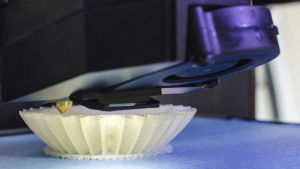Everything Business Leaders Need To Know About 3D Printing
The technology is predicted to have a $550bn economic impact by 2025.

The global 3D printing market size was estimated to be worth US$ 9.9 billion in 2018. By 2025 it is expected to surpass USD $63 billion. This innovative technology enables businesses to design, produce, and sell unique personalized products at a low cost and rapid rate.
It is estimated that 3D printing and related technologies could have an impact of up to $550 billion a year by 2025. It’s increasingly clear that it will be essential for manufacturing businesses to embrace this technology to thrive over the next decade.
3D printing is also key to business’ ability to help deliver the UN’s goals for sustainable development. It has the power to greatly reduce the impact the manufacturing sector has on the planet – reducing waste, increasing global resource efficiency and localising manufacturing to reduce transportation needs.
So here’s everything business leaders need to know to utilise this new tech and get ahead.
Market size
A number of factors have driven the growth of the 3D printing industry. Firstly, it makes it easy for businesses to develop customized products and reduces manufacturing costs and waste. Government investment in 3D printing projects have also had a huge impact, as have the development of new industrial-grade 3D printing materials.
The additive manufacturing industry is expected to achieve a compound annual growth rate of 26.4 percent between 2020 and 2024. With a surge in technological advancements and product innovations, 3D printing technology finds application in a wide variety of areas with the potential to disrupt the entire manufacturing industry.
Government investment
Governments across the globe have started investing in research and development surrounding 3D printing. This has had a positive impact on technology adoption.
The Dutch government, for instance, has invested an additional $150 million in 3D printing-related research and innovation. In emerging economies, the 3D printing market is expected to be worth $4.5 billion by the end of 2020. Countries such as China, India, UAE, Brazil and South Africa are investing substantially in 3D printing technology too.
Among the emerging nations, China holds the lion’s share. As early as April 2013, China’s Ministry of Science and Technology had invested $6.5 million into a National High Technological Research and Development Program to promote the technology and increase the adoption rate of 3D printing.
The power of 3D printing
Additive manufacturing has great potential to alter entire economies of scale. It changes the equation, both impacting existing businesses and creating opportunities for emerging small-scale entities that may serve more local markets.
As well as enabling businesses to design, produce, and sell unique personalized products at a low cost, while producing less waste, it also promotes use of local products such as plastics and shifts markets towards closed-loop production and consumption.
For instance, innovative start-up Genetics is battling food waste by turning it into something of use. Under this novel structure, food waste is converted into biodegradable plastics.
Using the power of biotechnology, machine learning, and microbial engineering, the team at Genetics is able to create a form of plastic from food waste that can be used to create more sustainable toys, medical devices and 3D printer filament.
Perhaps the most impactful aspect of the technology is its flexible nature, meaning that businesses can rapidly create prototypes during the development phase for new products and then reconfigure existing equipment to manufacture new products.
The technology has the potential to enable new business models while positively impacting manufacturing and distribution across a range of sectors.
Tech for good
3D printing is an amazing part of the tech for good movement. It is poised to play a significant role in the manufacturing sector with regards to reducing waste, challenging global supply chains and increasing flexibility in the manufacturing process.
It can be leveraged for good across the world, providing an opportunity for products to be produced anywhere. Not only does this give businesses access to new markets and regions, it enables the globalization of business and the creation of new business models.
From a business cost savings perspective, 3D printing eliminates the need for warehouses to overstock inventory. Not only does it allow for more efficient production by reducing demand for raw materials, the technology also reduces the need for global distribution and supply chains because of localized production.
3D printing can be considered a greener manufacturing model because it uses only the materials necessary to be consumed and nothing extra. By contrast, conventional subtractive production techniques waste resources.
Some projects in the sector highlight this more ecological and sustainable aspect by offering multiple solutions for recycling waste. Businesses are already using 3D printing for good in a variety of innovative ways.
Market demand to eliminate waste has spurred a unique business model for 3D printing. For instance, Dutch company 3Devo’s SHR3D IT machine is capable of transforming plastic waste into 3D printable granules. In just one hour, it can recycle 5.1 kilograms of plastic.
Market sectors
Additive manufacturing is impacting a wide range of sectors, but most significantly the healthcare, infrastructure, food, and aerospace industries.
In the healthcare industry, the business of 3D printing is a vast and largely untapped market. Additive manufacturing, for instance, allows for healthcare professionals to have potentially instant access to prosthetics for patients. Additionally, medical device manufacturing can also benefit greatly from the precision and customization that 3D printing offers.
In infrastructure, 3D-printed buildings are a possible solution for low-income housing. Within the food industry, additive manufacturing will give consumers more choice and greater accessibility to foods, as well as increase our ability to feed the hungry in some areas of the world.
Within the aerospace industry, additive manufacturing could cut the time it takes to manufacture planes in half.
The time to embrace 3D printing is now – for manufacturers, it will be key to their ability to survive and thrive in the next decade.
Marga Hoek is a global thought-leader on sustainable business, international speaker and the author of The Trillion Dollar Shift, a new book revealing the business opportunities provided by the UN’s Sustainable Development Goals.
The Trillion Dollar Shift is published by Routledge, in hardback and e-book. For more information go to www.margahoek.com
Thanks for signing up to Minutehack alerts.
Brilliant editorials heading your way soon.
Okay, Thanks!

